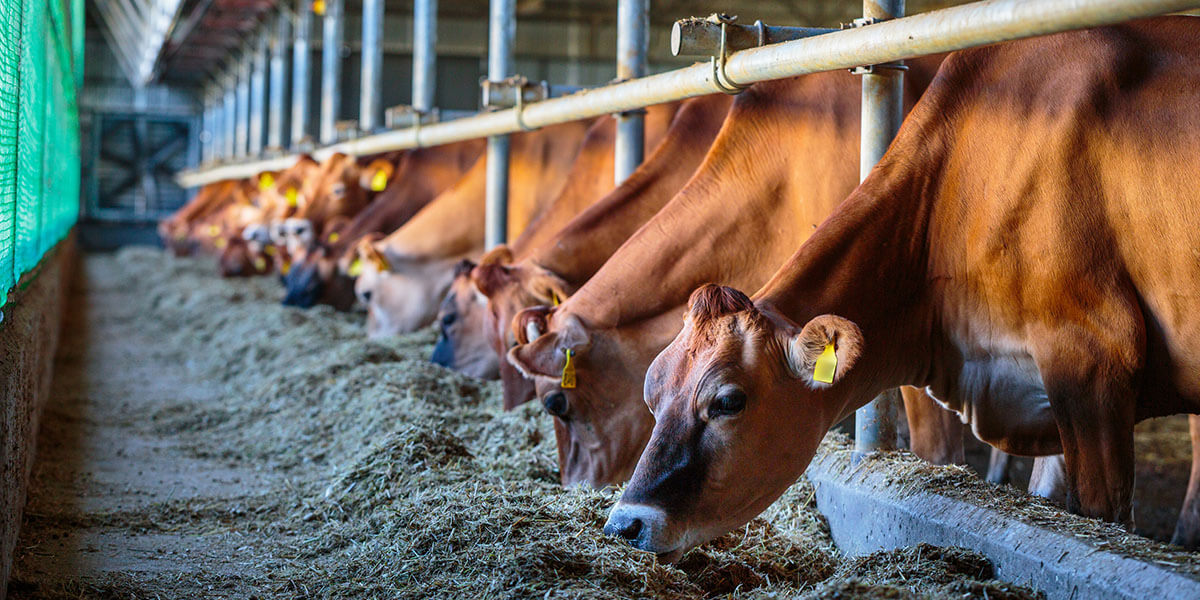Lorsqu'il s'agit de supplémenter les vaches laitières en cuivre de cuivre dans l'alimentation des vaches laitières, les producteurs laitiers doivent s'assurer qu'ils qu'ils répondent aux besoins de l'animal pour des performances optimales, tout en s'assurer que les niveaux de supplémentation ne sont pas assez élevés pour provoquer une une accumulation excessive de cuivre dans le foie.
Le cuivre est un élément essentiel d'une variété de fonctions métaboliques et structurelles chez les bovins laitiers, y compris les fonctions suivantes
- Formation de pigments de mélanine
- Production d'ATP
- Absorption et métabolisme du fer
- Maturation des globules rouges
- Fonction immunitaire
- Liaison disulfure et protéines kératiniques
- Formation de collagène
En cas de supplémentation excessive, le cuivre peut devenir toxique. Dans le cas d'une suralimentation extrême, le foie foie accumule des niveaux élevés de cuivre. Les vaches peuvent ne pas montrer de signes de ce phénomène jusqu'à ce qu'un événement stressant nécessitant une activité catabolique accrue du foie déclenche la libération d'une énorme quantité de cuivre. catabolique du foie déclenche la libération d'une énorme quantité de cuivre dans le sang (hémolyse). dans le sang (crise hémolytique), ce qui peut entraîner les conséquences suivantes :
- Hémolyse importante, c'est-à-dire la rupture des globules rouges, libérant de l'hémoglobine dans le sang et, par conséquent, une perte de poids. des globules rouges, libérant de l'hémoglobine dans le sang et, par conséquent, diminuant la quantité d'oxygène dans le corps, diminuer la quantité d'oxygène dans le corps.
- La jaunisse, qui est le résultat de quantités excessives du pigment bilirubine dans le sang.
- Nécrose généralisée, c'est-à-dire la mort de la plupart ou de la totalité des cellules d'un organe ou d'un tissu en raison d'un défaut d'approvisionnement en sang. ou de toutes les cellules d'un organe ou d'un tissu en raison d'une défaillance de l'approvisionnement en sang.
- Et même la mort.
Échantillon de foie de l'industrie Les résultats de plusieurs sources indiquent que même des niveaux modérément élevés de supplémentation en cuivre peuvent être problématiques. de cuivre peuvent être problématiques. C'est pourquoi l'évaluation de l'état du cuivre au niveau du troupeau.
Déterminer le statut du cuivre
Le tissu hépatique est l'indicateur Le tissu hépatique est l'indicateur idéal du statut en cuivre chez les animaux et reflète la disponibilité à long terme du cuivre alimentaire (Herdt et Hoff, 2011). disponibilité à long terme du cuivre alimentaire (Herdt et Hoff, 2011). Le cuivre se lie à la métallothionéine dans le foie, ce qui est important car un excès de cuivre libre dans le foie peut endommager les membranes lipidiques hépatiques. dans le foie peut endommager les membranes lipidiques hépatiques et le cuivre est un pro-oxydant.
La teneur en cuivre du foie se situent entre 75 ppm et 300 ppm sur la base du poids sec (Puls, 1994). Dans le passé, les Dans le passé, les préoccupations concernant l'accumulation excessive de cuivre n'apparaissaient pas avant que les niveaux ne dépassent 750 ppm de poids sec. de 750 ppm de poids sec, mais il est prouvé que les producteurs devraient de la supplémentation si les niveaux de cuivre hépatique dépassent 500 ppm de poids sec. hépatiques dépassent 500 ppm de poids sec.
Lyman et al. (2015)
ont constaté que les concentrations hépatiques de cuivre chez les vaches laitières de réforme s'élevaient en moyenne à
environ
500 ppm, et nombre de ces échantillons présentaient des signes de peroxydation des membranes lipidiques.
Schefers (2015) a expliqué comment les niveaux d'enzymes hépatiques sanguines étaient élevés lorsque les
lorsque les concentrations hépatiques de cuivre étaient supérieures à 450 ppm, ce qui indiquait des
dommages hépatiques.
Les échantillons de foie prélevés au hasard par Zinpro sur des vaches laitières saines en milieu de lactation entre 2000 et 2017 montrent que la concentration hépatique en cuivre de ces vaches échantillonnées au hasard se situe juste à la limite de l'inquiétude. En regardant de plus près, on peut toutefois constater qu'un nombre important de vaches présentent des niveaux beaucoup plus élevés.
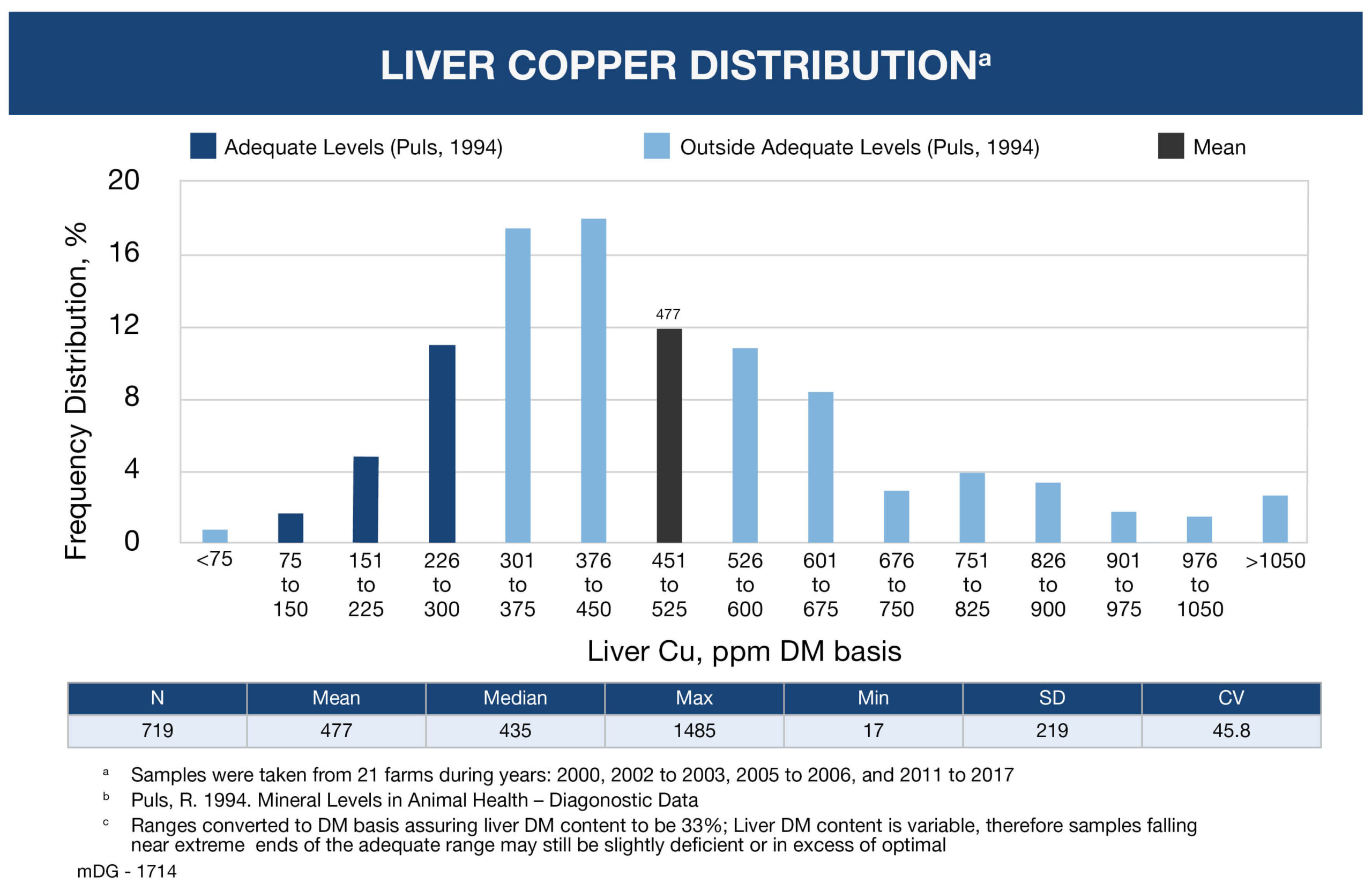
Causes potentielles d'une accumulation excessive de cuivre
Plusieurs facteurs facteurs qui peuvent contribuer à une accumulation excessive de cuivre. L'entretien et la gestation sont les principaux facteurs des besoins en cuivre et, dans une moindre mesure, la production de lait, dans une moindre mesure, la production de lait. Cependant, les vaches laitières d'aujourd'hui consomment plus de matière sèche que par le passé en raison d'une production laitière plus élevée. plus de matière sèche que par le passé en raison de l'augmentation de la production laitière. Une vache qui mange 27 kg de matière sèche consommera 90 mg de cuivre supplémentaires par jour, par rapport à une vache qui ne consomme que 50 kg de matière sèche. par rapport à une vache qui ne consomme que 23 kg, en supposant un niveau de 20 ppm de cuivre alimentaire total. de cuivre alimentaire total. Cela peut sembler peu, mais cela fait une différence significative au cours de la vie d'une vache. En outre, lorsque la consommation d'aliments augmente, le taux de passage des aliments augmente également, ce qui réduit la quantité de cuivre dans l'alimentation. la vitesse de passage des aliments, ce qui réduit le temps d'exposition du cuivre aux antagonistes (molybdène). antagonistes (molybdène et soufre), ce qui peut entraîner une plus grande absorption du cuivre.
Les concentrations hépatiques de cuivre ont augmenté d'environ 230 ppm de poids sec lorsque les vaches laitières en lactation sont supplémentées avec 12 à 15 ppm de cuivre pendant deux lactations (Nocek et al., 2006). Le seul moment où le cuivre hépatique tend à diminuer au cours de la vie d'une vache, en dehors d'une suppression délibérée de la supplémentation en cuivre, est la période de tarissement. Cela peut s'expliquer par la nécessité de répondre aux besoins du veau en développement et par le fait que l'ingestion de matière sèche est jusqu'à 50 % inférieure à celle d'une vache en lactation. Cependant, peu après le vêlage, l'accumulation de cuivre reprend et dépasse souvent le niveau maintenu pendant la lactation précédente.
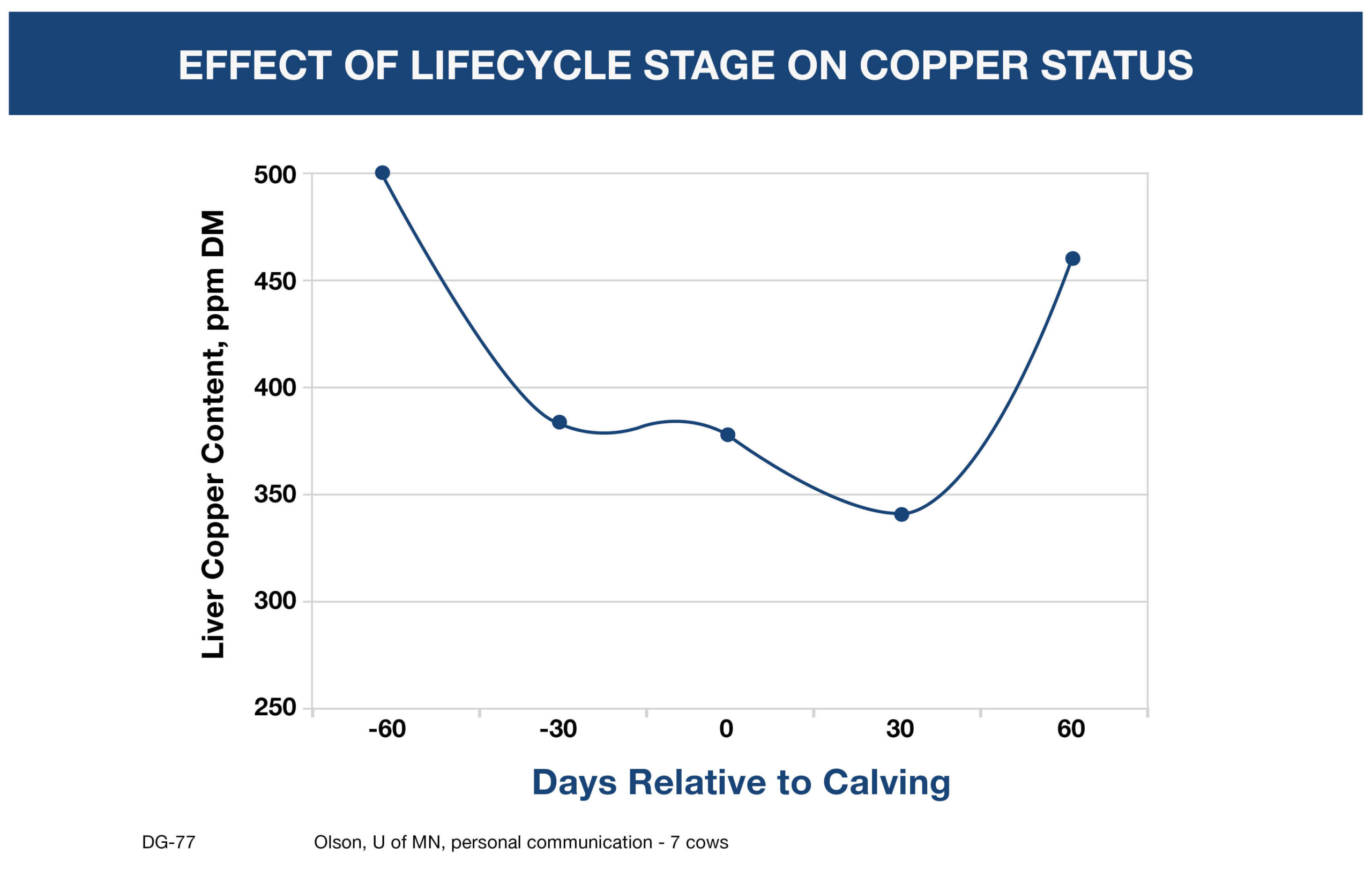
Une autre cause possible L'accumulation excessive de cuivre peut également être due au fait que les nutritionnistes utilisent des valeurs comptables au lieu de valeurs analysées pour les minéraux. des valeurs comptables au lieu des valeurs analysées pour les minéraux. Il est fortement déconseillé d'utiliser les valeurs est fortement déconseillée car la teneur en oligo-éléments peut être très variable en fonction des différentes différentes conditions agricoles, y compris la concentration de minéraux dans le sol, le pH du sol, la situation géographique, la contamination du sol au cours de l'élevage, etc. pH du sol, la situation géographique, la contamination du sol pendant la récolte et le type de fourrage. Les légumineuses accumulent de plus grandes quantités de Cu que les graminées. Les légumineuses accumulent de plus grandes quantités de Cu que les graminées.
L'utilisation de bains de pieds à base de sulfate de cuivre de sulfate de cuivre dans une ferme pourrait également être un facteur contribuant à une l'accumulation excessive de cuivre. On estime qu'une exploitation laitière de 1 000 vaches qui utilise trois fois par semaine un pédiluve à base de sulfate de cuivre à 5 de sulfate de cuivre trois fois par semaine contribuera à l'accumulation d'environ deux tonnes de cuivre dans le fumier chaque année. tonnes de cuivre au fumier chaque année, qui est ensuite épandu dans les champs. Le fumier est souvent épandu sur les terres les plus proches de la ferme, de sorte qu'il peut y avoir une accumulation effective sur le terrain dans ce scénario. Il peut donc y avoir une accumulation effective sur le terrain dans ce scénario.
Même si le cuivre s'accumule tout au long de la vie de l'animal, l'inquiétude à ce sujet n'est pas ne se limite pas aux bovins laitiers âgés. Kendall et al. (2015) ont observé que les niveaux de cuivre dans le foie de cuivre dans le foie des vaches laitières de réforme ne différaient pas en fonction de l'âge une fois que les vaches avaient atteint deux ans (2 à 15 ans). deux ans (de 2 à 15 ans). Gomez et al. (2014) ont constaté que les bouvillons Holstein de 300 à 600 livres de poids corporel avaient des niveaux de cuivre dans le foie supérieurs à 500 ppm. des niveaux de cuivre dans le foie supérieurs à 500 ppm de poids sec. Lyman (2013) a présenté études de cas où des génisses de moins de 550 livres et des bouvillons de moins de quatre mois présentaient déjà des signes de toxicité du cuivre. L'accumulation de cuivre peut commencer in utero, Graham et al. (1994) ont constaté que les niveaux de cuivre dans le foie étaient similaires entre les mères et les fœtus. En outre, des rapports de terrain ont indiqué que les niveaux de cuivre dans le foie des veaux Holstein dépassent dans certains cas 500 ppm de poids sec.
Répondre aux besoins en cuivre de l'animal
Dans la plupart des cas, les suppléments d'oligo-éléments devraient fournir 8 ppm à 10 ppm de cuivre supplémentaire aux vaches et génisses Holstein, avec la mise en garde de ne pas dépasser 400 mg de cuivre alimentaire total par jour. Les recherches menées par Zinpro montrent qu'un apport supérieur à 400 mg de cuivre par jour peut entraîner des taux de cuivre dans le foie supérieurs à 450 ppm de matière sèche, que la source de cuivre soit inorganique ou qu'elle provienne d'oligo-éléments (Kellogg et al., 2003, Ferguson et al., 2004, Nocek et al., 2006, Ballantine et al., 2002, Griffiths et al., 2007, Siciliano-Jones et al., 2008, Hackbart et al., 2010).
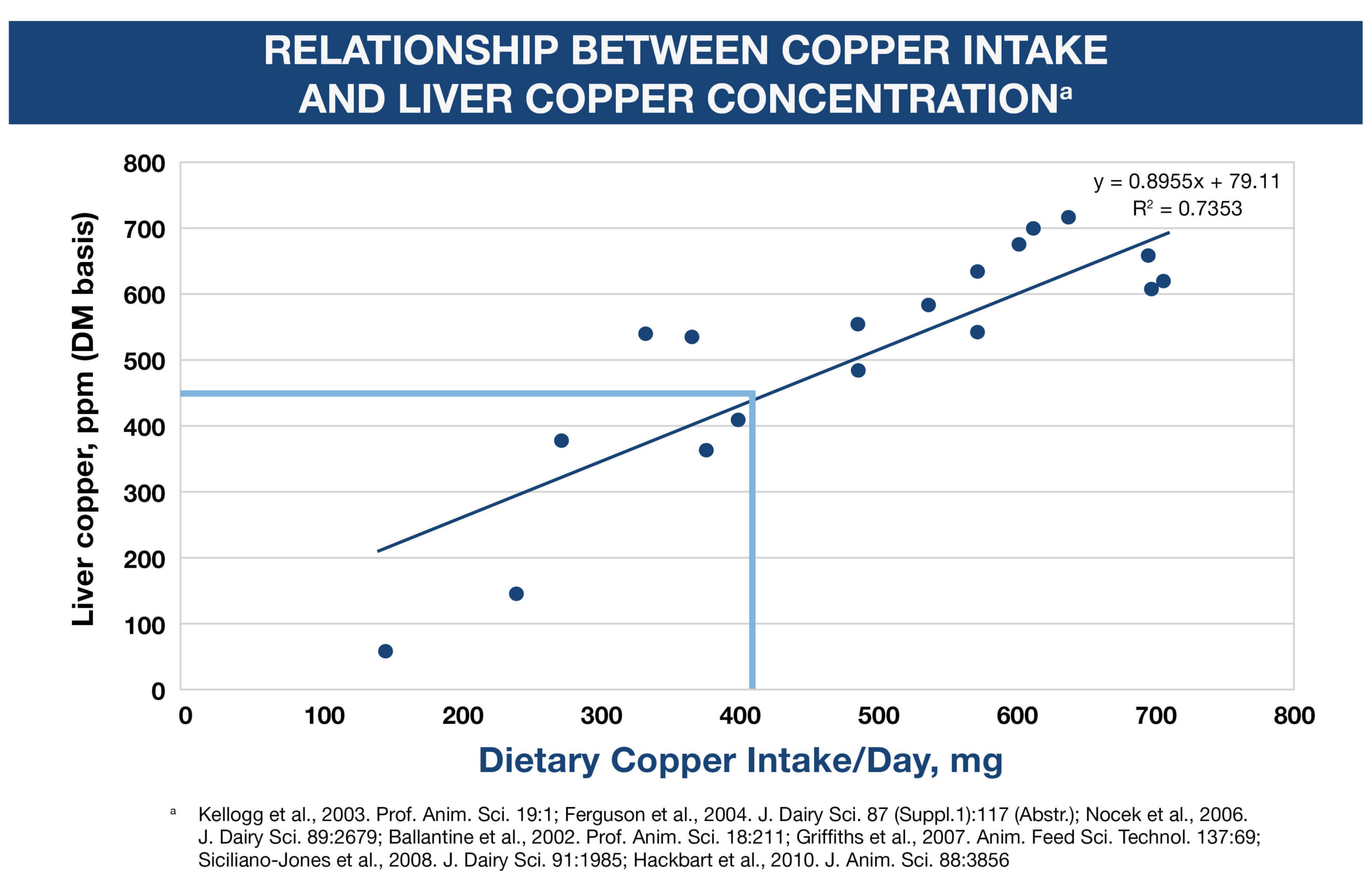
Les vaches et génisses Jersey sont plus efficaces pour accumuler le cuivre dans le foie (Du et al., 1996). Il faut donc limiter la supplémentation à 6 à 8 ppm, soit un maximum alimentaire total de 300 mg de cuivre par jour. 300 mg de cuivre par jour.
Enfin, 3,5 à 5 ppm de cuivre supplémentaire doivent provenir d'une source moins sensible au stress et aux antagonistes. L'inclusion de cuivre complexé avec un acide aminé, tel que le Availa® CuL'administration d'Availa Cu à des vaches laitières stressées améliore la rétention du cuivre par rapport au sulfate de cuivre inorganique. Cela suggère une activité métabolique différente lorsque le cuivre est administré sous forme d'Availa Cu.
Pour s'assurer que les vaches laitières reçoivent la bonne quantité de cuivre, les nutritionnistes devraient prélever un échantillon d'eau au moins une fois par an afin de rester attentifs aux antagonistes potentiels, tels que le fer ou les sulfates. Ensuite, ils devraient tenir à jour une bibliothèque d'aliments pour animaux comprenant des analyses d'oligo-éléments pour leurs laiteries, au lieu d'utiliser les valeurs comptables. Cela leur permettra de disposer d'un point de référence fiable sur les niveaux de base de cuivre et d'antagonistes au sein d'une exploitation ou d'une région. Lorsque les niveaux de molybdène et de soufre alimentaires sont élevés, il peut être nécessaire de modifier les recommandations mentionnées précédemment. Une façon d'y parvenir est de maintenir une ration cuivre/molybdène de 4:1, en particulier lorsque les niveaux de soufre dépassent 0,3 pour cent. Comme le montre le tableau ci-dessous, lorsque les teneurs en soufre sont plus proches de 0,2, cette modification est moins nécessaire. En outre, si les régimes alimentaires sont riches en molybdène et en soufre, et que les conditions sont donc favorables à la formation de thiomolybdates, les producteurs devraient envisager de fournir une partie du cuivre supplémentaire à partir d'une source de cuivre disponible dans le rumen afin de réduire l'absorption des thiomolybdates. Les thiomolybdates absorbés empêcheront le cuivre absorbé d'être métaboliquement disponible.
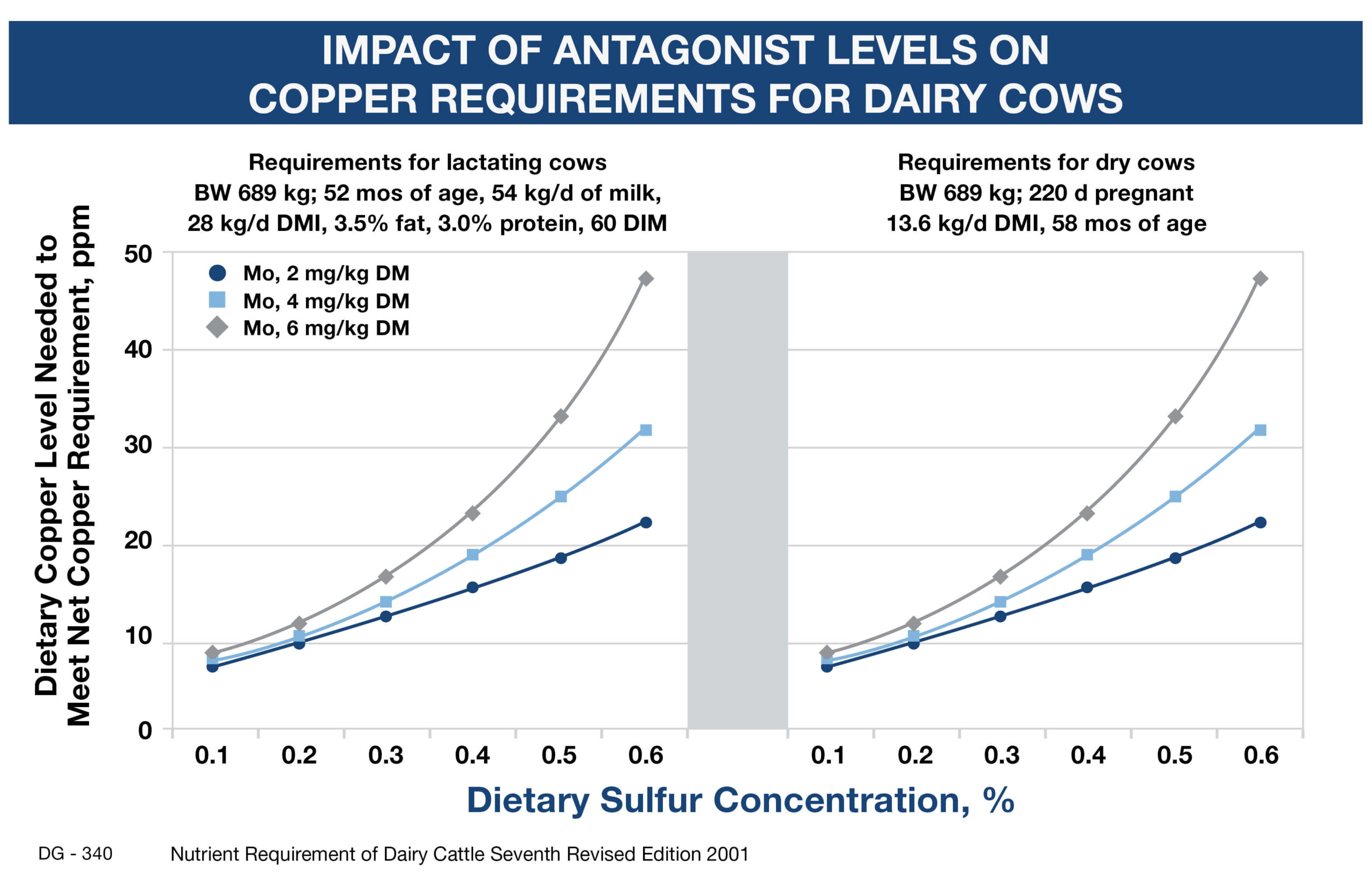
Le cuivre est un nutriment essentiel nécessaire à de nombreuses fonctions biologiques, mais il est également possible d'avoir trop d'une bonne chose. Compte tenu des facteurs que sont l'augmentation de l'ingestion d'aliments et des niveaux de cuivre basaux plus élevés dans les régimes, ainsi que l'accumulation excessive de cuivre dans les tissus hépatiques, les régimes doivent être conçus avec précision pour la supplémentation en cuivre.
Pour en savoir plus sur les niveaux de cuivre appropriés pour les vaches laitières, ou pour poser des questions sur l'utilisation du cuivre dans les vaches laitières, cliquez ici. Availa Cu pour votre programme de nutrition du bétail laitier, contactez votre représentant Zinpro dès aujourd'hui.

